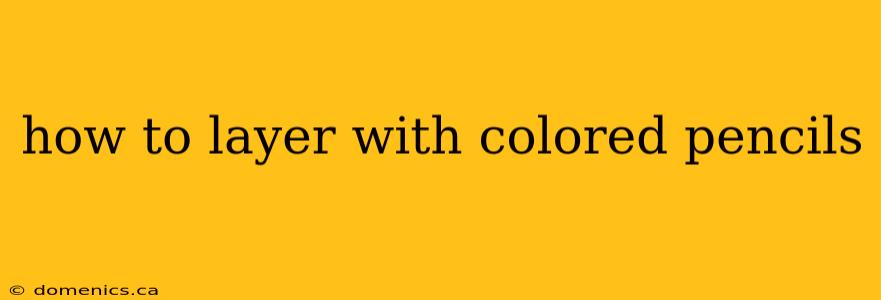Meta Description: Unlock the secrets to vibrant, realistic art! Learn how to layer colored pencils like a pro with this comprehensive guide. Master blending techniques, color mixing, and more to elevate your drawings. Discover expert tips and tricks for achieving stunning results with colored pencils, from beginner to advanced techniques.
Colored pencils are a versatile medium capable of producing stunning works of art. Mastering the art of layering is key to unlocking their full potential. Layering colored pencils allows you to build depth, richness, and vibrancy in your drawings. This comprehensive guide will walk you through the process, covering everything from basic techniques to more advanced methods.
Getting Started: Essential Supplies and Techniques
Before diving into layering, ensure you have the right tools. High-quality colored pencils are essential for achieving smooth, even layers. Brands like Prismacolor Premier, Faber-Castell Polychromos, and Caran d'Ache Luminance are popular choices among artists. You'll also need:
- Sharpener: A quality sharpener is crucial for maintaining fine points. Consider both an electric and a hand-held sharpener for different needs.
- Blending tools: These can include colorless blender pencils, tortillons (paper blending stumps), or even cotton swabs.
- Paper: Choose a paper specifically designed for colored pencils, such as Stonehenge or Bristol board. These papers have a smooth surface that minimizes tooth, allowing for smoother layering.
- Eraser: A kneaded eraser is ideal for lifting color without damaging the paper.
Understanding the Layering Process
Layering colored pencils involves applying multiple layers of color over one another. Each layer adds depth, modifies hue, and enhances the overall effect. This is unlike other mediums where you might blend colors directly on the palette. Here’s the basic principle:
- Underpainting (Base Layer): Lay down light, even layers of color to establish the base tones and values.
- Building Layers: Gradually add darker and more saturated layers to create depth and detail.
- Blending: Use blending techniques to soften transitions between colors and create smooth gradients.
Layering Techniques: From Basic to Advanced
1. Basic Layering: The Foundation
Begin with a light base layer. Don't press too hard; keep your strokes light and even. Subsequent layers will build upon this foundation. Think of it like painting a watercolor wash: several thin layers are preferable to one thick, muddy one.
Tip: Always work from light to dark. This prevents you from having to erase or lift large areas of color.
2. Color Mixing: Expanding Your Palette
Colored pencils allow you to create a wider range of colors by layering different hues. Layering a warm color over a cool color (or vice versa) can create interesting effects. For instance, layering a yellow over a blue will create green. Experiment!
Tip: Use complementary colors (opposite each other on the color wheel) to create vibrancy and depth.
3. Burnishing: Achieving Smoothness
Burnishing is the technique of layering color over previously applied layers using firm pressure. This creates smooth, even areas of color, eliminating visible pencil strokes. A colorless blender can be particularly helpful here.
Tip: Don't burnish too heavily, as this can damage the paper. Work in small sections.
4. Scumbling: Creating Texture
Scumbling involves lightly layering colors over one another with short, broken strokes. This technique creates a textured appearance and adds visual interest to your artwork. Think of it as applying a textured overlay.
Tip: Use a lighter touch for more subtle texture.
5. Lifting Color: Refining and Correcting
Lifting color is essential for correcting mistakes and refining your work. A kneaded eraser is the perfect tool for this. Gently roll it over the area you want to lighten.
Advanced Layering Techniques
6. Underpainting with Watercolors
A less common but powerful method is to start with a watercolor underpainting. Let this dry completely. Then, layer colored pencils on top. The watercolor provides a beautiful base layer and allows for excellent color mixing capabilities.
7. Using Different Pencil Grades
Using a variety of pencil grades (e.g., hard, medium, soft) allows for more control over the layering process. Hard pencils are best for initial layers, while soft pencils can be used to add depth and richness.
Troubleshooting Common Layering Problems
- Muddy colors: This often happens when applying too much pressure or using too many layers of dark colors at once. Work in thinner layers and use lighter pressure.
- Uneven color: Make sure your pencil is sharpened and use consistent, even strokes.
- Wax bloom: This is a whitish buildup on the surface of the paper, caused by the wax in the colored pencils. It's usually resolved with a light application of a colorless blender.
Conclusion: Mastering the Art of Layering Colored Pencils
Mastering colored pencil layering is a journey, not a destination. By understanding the techniques described above and practicing regularly, you'll be well on your way to creating stunning, realistic artwork. Remember to experiment, be patient, and most importantly, have fun! The more you practice, the more confident and proficient you'll become in this rewarding art form. Remember to always start with light layers and gradually build up the intensity of your colors.
